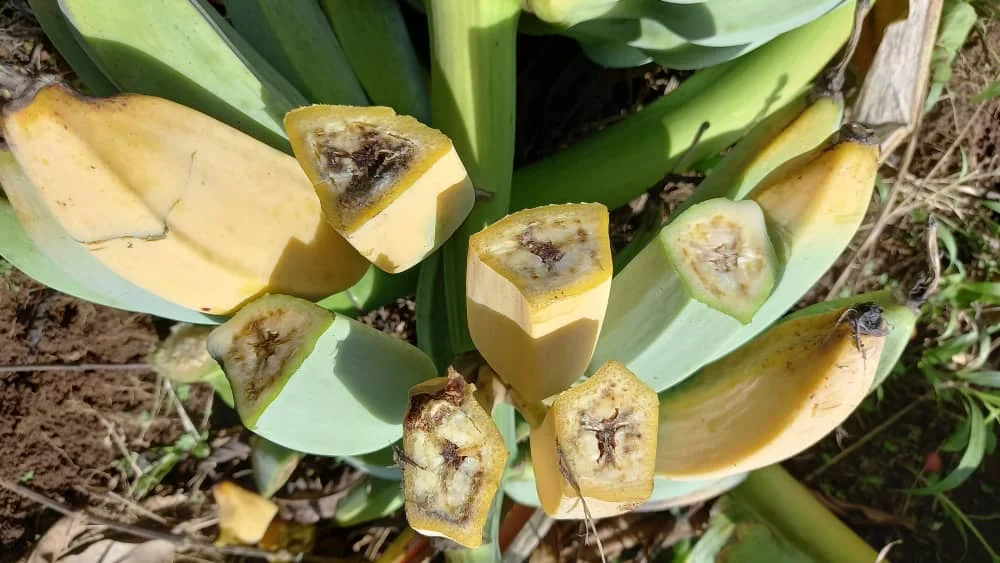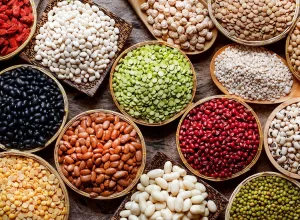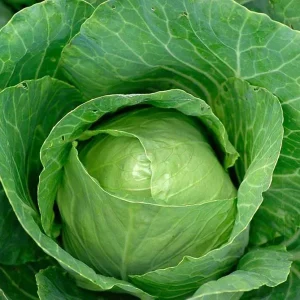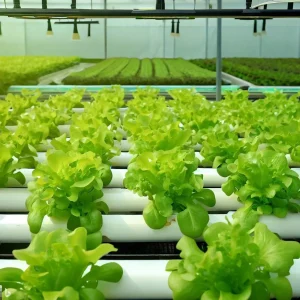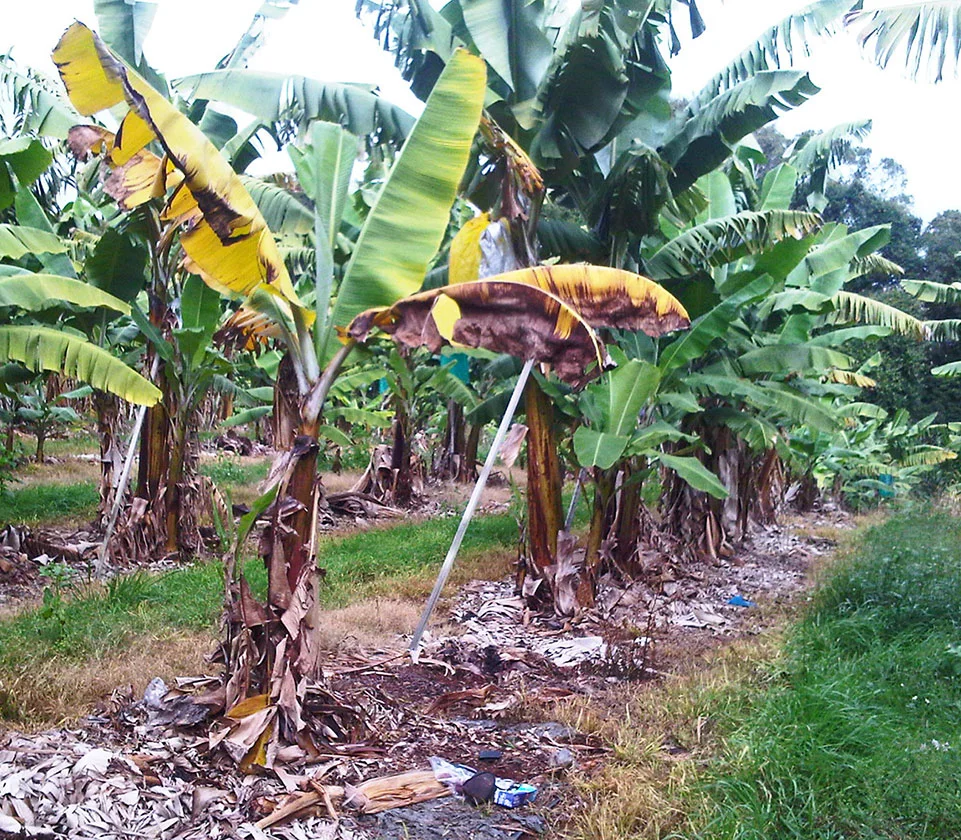
Bananas, are a staple fruit in many households around the globe, are not just a delicious and nutritious snack but also a crucial crop for millions of farmers. However, banana cultivation faces significant challenges due to various banana diseases that can devastate crops, affect yields, and threaten livelihoods.
Understanding these diseases is essential for farmers, agricultural professionals, and even home gardeners who grow bananas. In this article, we will explore 10 banana diseases you should know about, detailing their symptoms, causes, and management strategies. Whether you’re involved in large-scale banana production or just interested in plant health and banana fertilizer, this guide will provide valuable insights into keeping banana plants healthy and productive.
10 Banana Diseases to Know About
- Panama Disease (Fusarium Wilt)
- Sigatoka Disease (Black and Yellow Sigatoka)
- Banana Bunchy Top Virus (BBTV)
- Banana Xanthomonas Wilt (BXW)
- Banana Leaf Spot (Leaf Blight)
- Banana Blood Disease
- Moko Disease
- Bacterial Wilt
- Cigar End Rot
- Anthracnose
1. Panama Disease (Fusarium Wilt) in Bananas
Panama Disease, also known as Fusarium Wilt, is one of the most destructive diseases affecting banana plants. It is caused by the soil-borne fungus Fusarium oxysporum f. sp. cubense.
The disease first gained prominence in the early 20th century when it wiped out vast plantations of the Gros Michel banana variety, leading to a shift to the Cavendish variety, which was initially resistant. However, new strains of the fungus have emerged, threatening even the Cavendish bananas.
Symptoms
The disease primarily affects the vascular system of the banana plant, leading to wilting and yellowing of the leaves.
The symptoms typically start with yellow streaks on the lower leaves, progressing to complete yellowing and wilting.
The pseudostem may show brownish streaks, and when cut open, the vascular tissues display a reddish-brown discoloration. Eventually, the plant collapses and dies, often before it can produce fruit.
Spread
Panama Disease spreads through infected soil, water, and plant material. The fungus can persist in the soil for decades, making eradication extremely difficult. It can also be spread by contaminated tools, footwear, and machinery.
Managing the Panama Banana Disease
One of the most effective ways to manage Panama Disease is by planting banana varieties that have natural resistance to the fungus.
Historically, the shift from Gros Michel to the Cavendish variety helped manage the disease’s impact.
Another strategy would be to Rotate banana crops with non-host plants to manage soil health and reduce the fungal population. In addition, banana farmers should consider chemical soil fumigation to reduce the population of the Panama Disease fungus in the soil.
This method involves treating the soil with chemical agents that kill the fungus. While effective, soil fumigation is expensive and can have negative environmental impacts, making it a less favorable long-term solution.
Sustainable practices and the use of biological controls are being explored as alternatives.
2. Sigatoka Banana Disease (Black and Yellow Sigatoka)
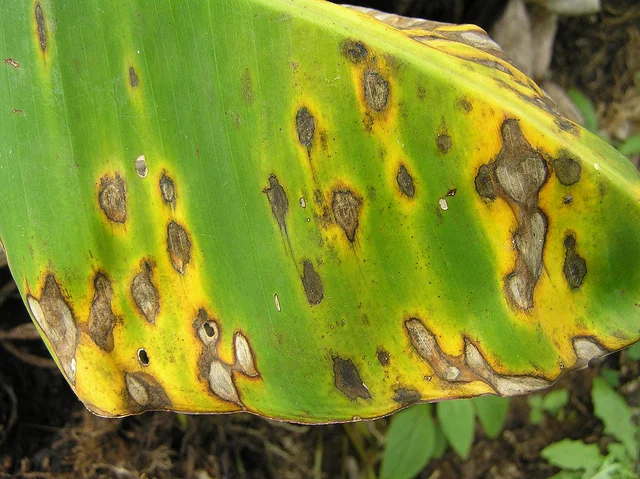
Sigatoka banana Disease, comprising Black Sigatoka (caused by Mycosphaerella fijiensis) and Yellow Sigatoka (caused by Mycosphaerella musicola), is a major threat to banana cultivation worldwide.
These fungal diseases affect the leaves of banana plants, reducing their photosynthetic capacity and thereby impacting fruit yield and quality.
Black Sigatoka is more aggressive and widespread compared to Yellow Sigatoka, but both can cause significant economic losses if not properly managed.
Symptoms
Both Black and Yellow banana Sigatoka disease manifest initially as small, light-colored streaks on the leaves.
In the case of Black Sigatoka, these streaks develop into dark brown or black spots, which eventually coalesce and cause large necrotic areas. This leads to premature leaf death.
Yellow Sigatoka, on the other hand, causes yellowish streaks that turn brown as the disease progresses
Spread
The spores of the fungi responsible for Sigatoka Disease are primarily spread by wind and rain. They can also be transferred through infected planting material. Favorable conditions for the disease include warm, humid climates with frequent rainfall, which facilitate the germination and spread of fungal spores.
Management of Sigatoka Banana Disease
Regular and strategic use of fungicides is one of the most effective methods for controlling Sigatoka Disease. Fungicides can help reduce the fungal load and protect new leaf growth. However, over-reliance on fungicides can lead to resistance, so it’s important to rotate different types of fungicides and follow recommended application schedules.
Similarly, growing banana varieties that are resistant to Sigatoka Disease is a sustainable approach to management. Lastly, maintaining good field hygiene is crucial in managing Sigatoka Disease.
3. Banana Bunchy Top Virus (BBTV)
Banana Bunchy Top Virus (BBTV) is one of the most severe viral disease affecting banana plants.
It is caused by the BBTV virus, which is transmitted by the banana aphid (Pentalonia nigronervosa). The disease leads to significant reductions in banana yield and can make commercial production unviable if not properly managed.
Also, the name “Bunchy Top” comes from the characteristic symptom of the disease where infected plants exhibit a rosette-like appearance due to the stunted growth of new leaves.
Symptoms of Banana Bunchy Disease
The initial symptoms of BBTV include dark green streaks on the leaf veins, midrib, and petioles.
As the disease progresses, new leaves become narrow, shortened, and bunched at the top of the plant, resembling a bunchy appearance. Furthermore, the leaves may also exhibit a chlorotic (yellowing) pattern, with the margins curling upward.
Infected plants show stunted growth, and the fruit bunches produced are often deformed and smaller in size. Eventually, the disease can cause the complete collapse of the plant.
BBTV is primarily spread by the banana aphid, which transmits the virus as it feeds on the sap of infected plants.
The virus can also be spread through the use of infected planting material. Once a plant is infected, it serves as a reservoir for the virus, which can then be spread to other plants by aphids.
Management of Banana Bunchy Disease
One of the most effective ways to manage BBTV is by using certified virus-free planting material. This prevents the introduction of the virus into new plantations.
Tissue culture plants and certified disease-free suckers should be used for establishing new banana crops.
Similarly, it is important to control the banana aphid population is crucial in managing the spread of BBTV. This can be achieved through the use of insecticides, biological control agents like ladybugs and lacewings, and cultural practices such as removing weeds and other plants that harbor aphids. Regular monitoring for aphid infestations and timely intervention are essential.
Lastly, Infected plants should be promptly removed and destroyed to prevent the spread of the virus. This includes digging up and disposing of the entire plant, including the corm (underground stem). Infected plant material should be burned or buried deep to prevent aphids from accessing it.
4. Banana Xanthomonas Wilt
Banana Xanthomonas Wilt (BXW) is also known as Banana Bacterial Wilt. It is a severe bacterial disease caused by Xanthomonas campestris pv. Musacearum.
It affects all banana varieties and can lead to substantial economic losses due to the death of plants and the reduction in yield. The disease was first reported in Ethiopia and has since spread to other parts of East and Central Africa, becoming a major threat to banana production in these regions.
Symptoms of Banana Xanthomonas Wilt
BXW manifests through a variety of symptoms that can appear on different parts of the banana plant. For example, the Infected plants exhibit wilting and yellowing of the leaves, starting from the margins and progressing inward.
Leaves then eventually collapse and hang down, giving a scorched appearance.
In addition, the Infected banana hearts (flowers) exude a yellowish bacterial ooze. The fruits from infected plants ripen unevenly and prematurely, often showing internal discoloration.
Cutting the pseudostem of an infected plant reveals a yellowish bacterial ooze, which is a key diagnostic feature of BXW.
Spread
BXW spreads through multiple vectors. The primary means of transmission are insects, such as bees and fruit flies, which are attracted to the banana flowers and spread the bacteria as they move from plant to plant.
Additionally, the bacteria can be spread through contaminated soil and water.
Management of the Banana Xanthomonas Wilt
To prevent the introduction of BXW into new plantations, banana farmers should use disease-free planting material. Suckers and tissue-cultured plants that are certified as free from the bacteria should be used to establish new banana crops.
Similarly, banana farmers should adhere to best sanitation practices such as regularly disinfecting tools to prevent the transfer of bacteria from infected to healthy plants.
Also, the removal and destruction of infected plants are critical to containing the disease. Infected plants should be uprooted and burned or buried deeply to prevent the spread of the bacteria. This includes removing and destroying all parts of the infected plant, including the corm and roots.
5. Banana Leaf Spot (Leaf Blight) Disease
Banana Leaf Spot, is commonly referred to as Leaf Blight disease. Banana leaf blight disease is a fungal disease caused by Mycosphaerella musicola. This disease is prevalent in banana-growing regions worldwide and can lead to significant reductions in yield and fruit quality.
Leaf Blight primarily affects the leaves of banana plants, impairing their ability to make food through photosynthesis
Symptoms
The disease initially appears as small, brownish-black specks on the leaves. These spots gradually enlarge and merge, forming large, irregularly shaped blighted areas.
As the infection progresses, the affected leaf tissue turns yellow and eventually dies, leading to extensive leaf damage.
Severe infections can cause premature leaf drop, leaving the plant with fewer functional leaves and significantly reducing its photosynthetic capacity. This can result in smaller, lower-quality fruit and reduced overall yield.
Spread of the Banana Leaf Blight Disease
The fungi that cause Leaf Blight spread through airborne spores, which can be carried by wind, rain, and contaminated tools. Furthermore, the disease thrives in warm, humid conditions, making tropical and subtropical regions particularly susceptible.
High humidity, frequent rainfall, and dense plantings can create an ideal environment for the disease to spread rapidly.
Management of the Banana Leaf Blight Disease
The use of fungicides is a common and effective method for managing Leaf Blight. Regular applications of fungicides can help control the spread of the disease and protect new leaf growth.
It is important to follow recommended application schedules and rotate fungicides to prevent the development of fungal resistance. Using fungicides as part of an integrated pest management (IPM) approach can help minimize environmental impact.
Another strategy would be the use of resistant varieties, and practicing good field hygiene. Banana farmers should also Remove and destroy infected leaves to reduce the source of fungal spores and limit the spread of the disease.
In addition, implementing proper disposal methods, such as composting at high temperatures, can help eliminate the fungal spores and prevent further infections.
Furthermore, enhancing airflow within banana plantations can help reduce humidity levels and the incidence of Leaf Blight.
Proper spacing of plants, regular pruning, and the removal of excess vegetation can improve air circulation and create a less favorable environment for fungal growth. Good airflow also helps the plants dry faster after rain, reducing the time the leaves are wet and susceptible to infection.
In conclusion, banana diseases, such as Panama Disease, Sigatoka, BBTV, BXW, and Leaf Blight, pose significant threats to banana cultivation worldwide, impacting yields and farmers’ livelihoods.
Effective management of these diseases requires an integrated approach, including the use of resistant varieties, strict sanitation, vector control, proper nutrient management, and regular monitoring.
By adopting these strategies, farmers can mitigate the impact of these diseases, ensuring healthier crops and sustainable banana production for the future.

